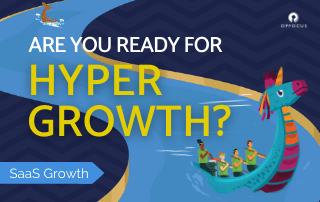
5 factors that drive hypergrowth – the SaaS Growth Readiness framework
 How mature is your SaaS organization? How do you know? Will you meet your growth objective this year? What might stop you? What is your timeline to hypergrowth?
How mature is your SaaS organization? How do you know? Will you meet your growth objective this year? What might stop you? What is your timeline to hypergrowth?
As SaaS growth experts, these are the questions that motivate OpFocus. We’re a passionate team dedicated to helping SaaS organizations use maturity benchmarking as a tool to achieve milestones and propel growth.
OpFocus created the SaaS Growth Readiness framework to help organizations measure their maturity, identify roadblocks and develop strategies to scale. We believe in data-driven decision making. To develop this framework, our team leveraged our years of experience with hundreds of clients to track data points, map trends, and create benchmarks. In the end, we created an invaluable tool to discover blind spots at every stage of growth.
Our data is clear: successfully growing a SaaS business is dependent on five cross-functional factors: People, Process, Technical Systems, Data, and Governance. From marketing to product to legal, these aspects govern the success of each team and the growth of a business.
People
This category represents the team members driving progress at every level of a business. Successful team management is the beating heart of every business, and includes training, culture development, operational capacity planning, organizational structure, HR, and hiring. Symptoms of companies struggling with team management include competing KPIs across departments, role dissatisfaction, employee attrition and siloed communication. For instance, our data shows that rapidly growing companies share certain characteristics: a strong culture of communication and shared accountability, a well-defined operational structure, and ideal person-role fit.
Ask yourself:
- Do you have the right team members in the right roles?
- Is there clear accountability and documented responsibilities for each position?
- How would you characterize the relationship between your organization’s functional areas?
a) Siloed
b) Shared metrics and strategy, but not completely aligned
c) Strong culture of communication and shared accountability
Process
Without identifying key processes in a centrally accessible place, teams and whole organizations rely on individuals to keep a business running. Can your team/department/business run if a key individual was, well, run over by a bus? A clear trend in operational growth readiness is the importance of documentation. Symptoms of companies with advanced process maturity include less time gathering data and reporting, shorter prioritization cycles, achieving goals according to clear expectations, and less time onboarding new hires.
Ask yourself:
- How much time is spent per month on manual processes across your business?
- What percentage of your organization’s key processes to sell products and track success of your customers are documented in a centralized repository?
- How accessible is your operational data internally?
a) Available only to the data owner
b) Department-level metrics tracked independently
c) Automated and centralized reporting and dashboards
Systems
Planning a tech stack and choosing tools is no small task. What you use depends on multiple factors, including cost, implementation time, functionality fit, training needs, ability to integrate, and more. After purchase, buyers often ignore an important question: When will your business outgrow this newly acquired tool? Proactively addressing this question is key to a successful scaling strategy. You may not be able to pinpoint a date, but recognizing the signs of an overstretched system will enable you to better plan and more efficiently support a growing team.
Ask yourself:
- How many tools does a team member typically use? Are there overlapping tools used by functional areas across the business?
- Do your tools serve you, or do you serve your tools?
- How long does it take to conduct monthly or quarterly reporting in each functional area? How much manual work is involved?
- What is the level of integration between your systems?
a) Completely separate with potential for duplicate data in multiple systems
b) Some integration eliminating some manual data transfer
c) Key systems seamlessly integrated
Data
To state the obvious: making data-driven decisions at any level of an organization is dependent on good data. Achieving good data quality takes intention, planning, and consistent effort. While organizations with nascent (or non-existent) data management can grow, lack of a clear strategy will eventually catch up and inhibit processes, people, and systems from scaling.
Ask yourself:
- How do you know if you’re ready to grow?
- What is your level of confidence in the cleanliness of your organization’s data?
- How would you characterize your organization’s ability to view a Customer 360?
a) Currently not possible given all the different places customer data lives
b) Salesforce and other key tools have most of the data, but we still need to piece it together
c) Centralized dashboards easily show the most up-to-date metrics - Are there cross-functionally determined definitions of specific teams? I.e. Does your organization have a set taxonomy?
Governance
Governance is the backbone of a successfully scaling business. In our framework, the definition of governance is intentionally broad to cover each opportunity for oversight and discipline at the individual, team, department and company levels. Key governance activities typically include change management, audits, prioritization and planning, checks and balances between functional areas, protocols for sensitive data, and system management. Governance provides clarity for team members on operational priorities, ensures compliance, and inspires confidence in processes, systems, and data.
Ask yourself:
- How does your organization handle change management? Is there a clear outline of steps and responsibilities for changes at the individual, team, department, or company level?
- How often do priorities change at the executive level?
- What is the process for new tool adoption?
Conclusion
As SaaS growth experts, OpFocus enables organizations to reexamine their operational maturity and create a cross-functional plan for growth. Our years of experience helping businesses at each stage of growth has enabled the OpFocus team to lead with this SaaS Growth Readiness framework.
Does your company have what it takes to hit your target ARR and YoY growth goals? Is your team ready to overtake your competitors and become a SaaS unicorn? Speak with our team for a rapid assessment of your SaaS growth readiness.


